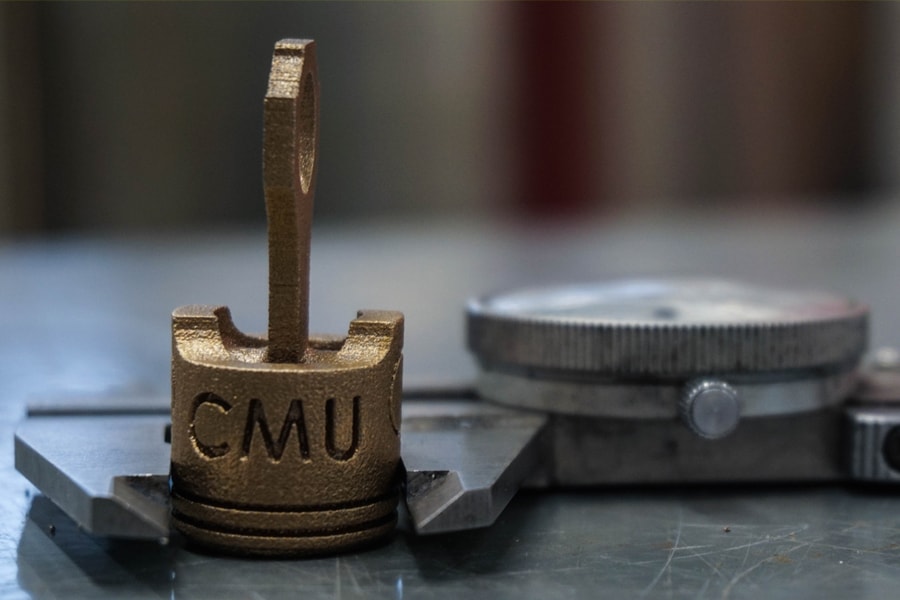
Driving Toward the Intersection of 3D Printing and Machine Learning
Applications of metal additive manufacturing, otherwise known as 3D printing, have primarily been confined to prototyping, but researchers are now pushing closer to developing metal 3D printing as a reliable form of industrial manufacturing. However, major obstacles still need to be addressed, especially in high-risk applications such as aviation components.
"One of the biggest hurdles between just making a part that looks good and actually putting it on an aircraft is making sure that the part you're producing doesn't have flaws in it," said Carnegie Mellon University alumnus Luke Scime.
Scime, who graduated with a doctorate in mechanical engineering and is now a post-doctoral researcher at Oak Ridge National Laboratory in Tennessee, worked with Mechanical Engineering's Jack Beuth, director of the NextManufacturing Center, to develop a machine learning algorithm that detects anomalies within a part as it's being printed — a practice known as process monitoring. The specific type of printing they worked with, laser powder bed fusion, involves spreading a thin layer of powder — 30 to 60 microns in diameter — and melting it in select areas to form a layer of the printed object. The process is then repeated for the next layer, with each build containing hundreds of thousands of layers. Many errors that can occur during a build are due to the incorrect spreading of the powder layer.
Researchers are attempting to use temperature monitoring, acoustic techniques, spectroscopy and other methods to get the best understanding of what is happening during a build at the structural level. Limited types of monitoring have been introduced commercially, however, most of these rudimentary forms offer only a reading to be interpreted by the machine operator without any capacity for automated analysis. Scime's work takes process monitoring to a new height, enabling automated analysis in real time through a computer vision algorithm.
"Computer vision is a term for using data analysis techniques to understand what's happening in an image," Scime said.
His algorithm takes images of the powder bed and extracts features from the images. It then groups them and compares these images across different levels of analysis, until it can create a unique "fingerprint" of the image. By feeding the algorithm hundreds of training images, already labeled manually with what's happening in the image, the machine learns to recognize the different flaws and how they appear. From there, the algorithm can take any new images it receives from the machine's built-in camera, and compare its fingerprint to those from its base of knowledge to successfully isolate anomalies.
In their most recent published paper, Scime and Beuth demonstrated that the algorithm can effectively detect flaws in powder spreading in the millimeter-sized scale range. These flaws have a major effect on the ability to print. The algorithm is able to spot these errors as they are developing and can determine what the flaw is and where it is occurring.
"The holy grail is to deploy this in a real-time environment where you're automatically analyzing data, doing something about it, and then moving on," Scime said.
According to Scime, the advance into self-correcting automation could look a couple different ways. At the most basic end of the spectrum, the machine could send an alert to an operator when it has detected an anomaly, allowing them to address the problem before continuing the build. The next level of sophistication would be automating simple fixes, allowing a machine to recognize a critical flaw and react accordingly. It could, for example, stop printing a certain part while allowing others to continue or clean the blade that spreads the powder bed. Each response would be tailored to correct the specific type of anomaly identified.
The pinnacle of automated self-correction would be in combatting an anomaly known as superelevation. Superelevation is when part of the build begins to warp or curl upward out of the powder layer, and is responsible for the majority of part damage. Developing an automated way to correct this type of flaw will test the limits of what researchers like Scime are capable of.
"What it really comes down to is, can we detect it, understand that it's an issue and then design what we call processing parameters to do something different than we were doing in order to reduce the amount of warpage?" Scime said.
Some of Scime's future interests lie in improving the accuracy of the machine learning algorithm and examining how more sensor data can be incorporated into its analysis. However, the current algorithm has been demonstrated to be effective at accurately identifying a range of anomalies and is ready for application. Scime hopes to continue to collaborate with CMU's College of Engineering and Beuth in the future.